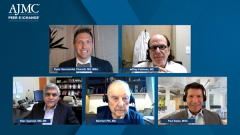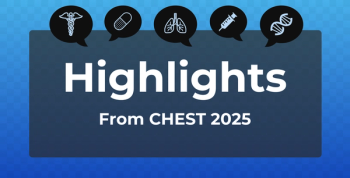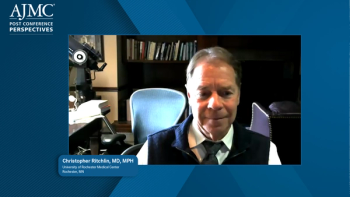
Preventing CKD Underdiagnosis
Paul Sapia, MHA, acknowledges the underdiagnosis in CKD and explains how payers can incentivize screening going forward.
Episodes in this series

Ryan Haumschild, PharmD, MS, MBA: Paul, I want to pivot to you because there’s underdiagnosis of CKD [chronic kidney disease], and underdiagnosis occurs in primary care, which is a big area of opportunity for our patients, with as many as 90% of individuals unaware that they have the disease. The NCQA [National Committee for Quality Assurance] Kidney Health Evaluation for Patients with Diabetes HEDIS [Healthcare Effectiveness Data and Information Set] measure was launched in 2020 to combat the underdiagnosis of CKD in this vulnerable patient population. Beyond this minimum standard measure of patients with diabetes, how can payers incentivize CKD screening through population health programs and perhaps internal quality measures? What does a successful prevention and screening program look like nowadays for this patient population?
Paul Sapia, MHA: That’s a great question, Ryan. Thank you for asking me. One of the things we start with is educating the primary care physicians on the new screening tools and the HEDIS metric, making sure they understand. A lot of providers are so focused on what they do day to day that we need to make sure they understand the screening measures and how to do it. Then once you identify, what do you do next? How do we create access so those members can get care and get access to the wellness programs, to the behavior changes that they need to do to slow or stop progression of kidney disease? We start to look at food and nutritionists and start to think about the whole-person health aspect of it.
The other part of it—Dr Feldman, I’m sure you’re very aware—are value-based provider contracts, looking at how we become partners in the care of our members. How do we provide the prevention? How do we provide the education to providers and partner with providers so they can have the resources needed to take care of the members? That helps us and the providers benefit through the value-based contracts, and then it helps the members have healthier days with everything we’re trying to do. That’s looking at value based, becoming a partner instead of just a payer, and [looking at] the care of the members.
There are a lot of examples of successful prevention programs. They may not be here in CKD, but there are a lot of examples. We’re doing the Health-Smart program in Jacksonville [Florida], with obesity and churches in very low-income communities, and helping people make small, smart changes, things that are attainable—that they can do to improve their health. Those are the prevention programs where we start early and we recognize people who have diabetes, who are obese or experiencing other health challenges, and how we help them make those small behavior changes.
It’s also connecting the resources within the community. A lot of us know tons of nonprofits and advocacy groups that are there to help, such as the National Kidney Foundation. There are educational resources for the members, family members and caregivers, and providers. It’s starting to bring all of that together. We use the collective impact model. We want to bring everybody together to start to point in the same direction. We can all be in different lanes and handle our different responsibilities, but we’re all progressing toward that final outcome of making patients and communities healthier. When we look at that value-based and that incentive-type program to help providers diagnose, screen, and take care of the members, that’s where the economic part comes in. That incentive for the provider groups is becoming more of a partner.
Ryan Haumschild, PharmD, MS, MBA: Dr Feldman, do you want to chime in? You operate in a similar context of care, so I’m curious about your thoughts.
Jeffrey Feldman, MD: I’m just the provider in our large ACO [accountable care organization]. We cover 3 different ACOs and over 400,000 lives in New Jersey communities, but we have 3 or 4 value-based contracts. We have weekly ACO 45-minute lectures. Our directors and managers talk about gaps in care and help our primary care see things: the low-hanging fruit, colorectal, and mammograms. We talk about A1C [glycated hemoglobin]. I believe UACR [urine albumin-to-creatinine ratio] is now one of our value-based goals.
They’re also looking at blood pressure. We just started with the cardiologist, and nephrologists are going to look at blood pressure. We have Epic [Systems] EHR [electronic health record] and a large database, and it turns out that there are people in their 20s and 40s whose blood pressures are high, and they never get back to their provider to get care. We’re beginning to close the gap. It takes a lot of resources and manpower, but we’re recognizing simple things that we can do with blood pressure and UACR, as Dr Agarwal said.
Dr Agarwal, I have a large population of primary care [physicians] sending [patients] to me, and it’s very frustrating. They order A1C, cholesterol, CMP [comprehensive metabolic panel], and a CBC [complete blood count], and there’s never any urine tests on there. When you send them things back, every third time, you may get a urine test. The other thing that’s very frustrating to me is that even if I give my patients a cup, they’ll go to the laboratory and say they can’t urinate. The phlebotomist thinks that’s wonderful because that’s 1 less test they have to do. You can go a year or 2, even with my patients who are on medications. I’m short a year without a UACR. It’s very frustrating.
I tell the patients, “Here are your laboratory tests, and I need a urine sample from you. Please make sure you give them a urine sample.” It’s up to us to elevate a urine sample, just like the lipid panel is such a wonderful tool. The urine has to be elevated, as you have in the past. I’ve heard you talk about it. Dr Pitt now believes it’s a cardiology tool, a risk factor that he can see. In our ACO, this is what we call low-hanging fruit, and we need to keep drilling it. Hopefully, as time goes on, those numbers Dr Agarwal gave us will increase and get into the 60s or 70s.
Transcript edited for clarity.
Newsletter
Stay ahead of policy, cost, and value—subscribe to AJMC for expert insights at the intersection of clinical care and health economics.














































